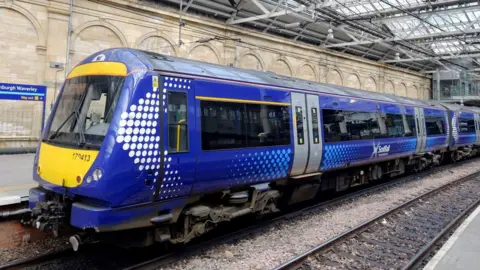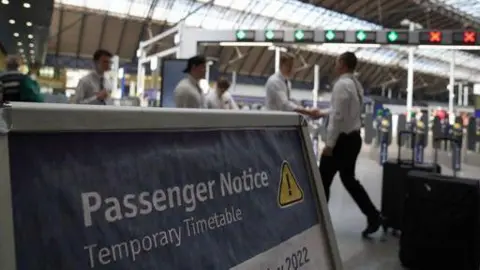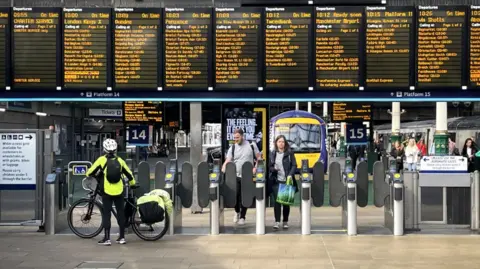When will ScotRail timetables return to normal?
 PA Media
PA MediaScotRail is still working on how to reintroduce a full timetable after the resolution of a pay row.
The company hopes to update customers on its plans within the next few days.
Here is what we know.
Why was the timetable reduced?
Under its normal timetable, ScotRail operates about 2,100 services every weekday, which then falls slightly during the weekend.
That is a drop of about 300 on pre-Covid levels, when ScotRail was run by its previous operator, the Dutch firm Abellio.
There are no plans to restore the number of services to those seen before the pandemic hit in March 2020.
Under the temporary timetable, which was put in place in July, about 600 were cut for an indefinite period while talks between ScotRail and its drivers were ongoing.
 PA Media
PA MediaScotRail said this was to preserve “certainty and reliability” of its services after four unions rejected its pay offer.
Drivers’ union Aslef became the last to accept the deal, which will give staff a 4.5% wage rise backdated to April, last week, following in the footsteps of the TSSA, Unite and the RMT.
However, ScotRail said there is no timetable in place for the reintroduction of a full service.
The operator’s communications director, David Ross, told BBC Radio’s Good Morning Scotland they were “working out driver availability” and an update would be provided “in the coming days”.
When will the normal timetable return?
There are unlikely to be any major improvements in the timetable before next Monday at the earliest.
ScotRail needs to find out whether staff are available for overtime, draw up new rosters and publish new timetables.
The process does not simply involve re-introducing the services completely withdrawn in July.
Some services in the emergency timetable do not run at the times customers may have been used to beforehand or stop at the same stations along the line.
Changes to the times of ScotRail services could also have implications for services on the same lines operated by other train companies.
The company is acknowledging that it will face some tough questions from the public if plans to return to the normal service are not set out soon.
In particular, any protracted process would lead to questions on the extent to which the company is over-dependent on overtime and rest day working.
Why was the temporary timetable necessary?
Simply put, ScotRail does not have enough drivers.
For the full timetable to run, the operator relies on drivers agreeing to do overtime and work on rest days, but that is entirely voluntary.
It is important to say at this stage that this is an issue which affects almost all rail companies across the UK and is not unique to ScotRail.
It is also worth noting, however, that the temporary timetable was in place for 80 days while a pilot scheme scrapping peak-time rail fares was in operation.
Due to the pay dispute, the unions put an overtime ban in place, stopping short of an outright strike, leading ScotRail to roll out a temporary timetable, cutting services that ran four times an hour in half.
During the last pay dispute in 2022, ScotRail agreed to try and recruit and train more drivers, but that takes between 18 and 24 months.
There are currently no vacancies, as of 30 September, for new drivers being advertised on the ScotRail website.
But as the company have already said, they still need to find out which drivers are willing to do overtime or rest day work before the timetable can be restored, and again, despite the negotiations over pay being brought to a close, that takes a bit of time.
Why are peak time fares back?
In August, Transport Scotland announced the scheme that scrapped peak-time fares would end from 27 September, citing “limited success”.
The transport secretary Fiona Hyslop said there had been an increase in passenger levels of about 6.8% during the 12-months the trial was in place.
However, she added it was not close enough to the 10% passenger uptick needed to meet the £40m needed for the scheme to be self-funding.
 PA Media
PA MediaThat meant the reintroduction of peak times and fares, with an additional increase in charges on top of that.
So, that £14.90 ticket between Edinburgh and Glasgow did not go back to costing £28.90. Instead, commuters are now charged £31.40 for that journey, a rise of about 8.6%.
To put that another way, the price for your ticket on Monday was 110% more expensive than it was last Friday.
How can I save on ScotRail tickets?
Off-peak fares are still available outside of peak times and for those on selected routes, including Inverness to Perth, Dundee to Kirkcaldy and Arbroath to Perth, super off-peak tickets can be used after 11:00, although restrictions from certain stations apply.
Additionally, a discount has been applied to the cost of all season tickets until 28 September 2025, which could save some commuters money if they travel on a daily basis.
ScotRail has also introduced a “Flexipass” ticket, which includes 12 single journeys for the price of 10, as long as they are used within a 60-day period.
A return ticket on the Flexipass counts as two journeys, so is equivalent to six returns.
On some routes, such as East Kilbride, Helensburgh or Neilston to Glasgow, that saving can be as much as 33%.
Railcards can also be used on full price tickets, and offer discounts of a third off the cost of a ticket, and 50% if aged 16 or 17.
